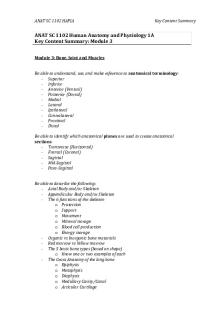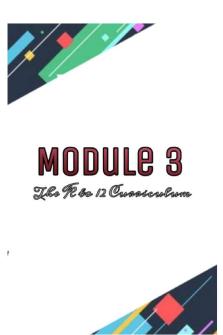Hapia - Module 3 - Key Content Summary PDF

| Title | Hapia - Module 3 - Key Content Summary |
|---|---|
| Author | Clair Nim |
| Course | Human Biology IA |
| Institution | The University of Adelaide |
| Pages | 4 |
| File Size | 75.6 KB |
| File Type | |
| Total Downloads | 58 |
| Total Views | 155 |
Summary
Download Hapia - Module 3 - Key Content Summary PDF
Description
ANAT SC 1102 HAPIA
Key Content Summary
ANAT SC 1102 Human Anatomy and Physiology 1A Key Content Summary: Module 3 Module 3: Bone, Joint and Muscles
Be able to understand, use, and make reference to anatomical terminology: - Superior - Inferior - Anterior (Ventral) - Posterior (Dorsal) - Medial - Lateral - Ipsilateral - Contralateral - Proximal - Distal Be able to identify which anatomical planes are used to create anatomical sections - Transverse (Horizontal) - Frontal (Coronal) - Sagittal - Mid-Sagittal - Para-Sagittal
Be able to describe the following: - Axial Body and/or Skeleton - Appendicular Body and/or Skeleton - The 6 functions of the skeleton o Protection o Support o Movement o Mineral storage o Blood cell production o Energy storage - Organic vs Inorganic bone materials - Red marrow vs Yellow marrow - The 5 basic bone types (based on shape) o Know one or two examples of each - The Gross Anatomy of the long bone o Epiphysis o Metaphysis o Diaphysis o Medullary Cavity/Canal o Articular Cartilage
ANAT SC 1102 HAPIA
-
-
-
Key Content Summary
o Periosteum & Endosteum Compact vs Spongy Bone (Function and Apperance) Haversian Systems o Haversian (central) canal o Concentric Lamellae o Interstitial Lamellae o Lacunae o Canaliculi o Volkmann’s Canal The 4 Bone cells (Development, Function, Location) o Osteoprogenitor o Osteoblast o Osteocyte o Osteoclast The 3 Types of cartilage (Appearance, Location, Function) o Hyaline (articular) cartilage o Fibrocartilage o Elastic cartilage
Be able to describe the steps during the process of bone formation (Ossification) - Intramembranous Ossification - Endochondral Ossification Be able to compare between the location and outcome of bone (or cartilage) growth - Interstitial Growth - Appositional Growth Understand the process of Bone Remodeling and factors that affect it - Function of Osteoclast & Osteoblast - Fracture Repair (steps) Be able to classify a joint based on its functional classification & structural class - Function Classification o Immobile o Partly Mobile o Free Mobile - Structural Classification o Bony o Fibrous o Cartilaginous o Synovial Be able to draw and describe the features of a synovial joint - Bone ends with articular cartilage - Joint cavity with synovial fluid - Synovial membrane & Joint Capsule - External Ligaments, Tendon, Vessels
ANAT SC 1102 HAPIA
Key Content Summary
Appreciate the 6 types of Synovial Joints with a focus on ball and socket - Ball and Socket - Hinge - Plane - Saddle - Condylar - Pivot Compare and contrast between structure and functional outcome of the Shoulder and Hip joint Muscles: Be able to describe the following: - Muscle Attachments o Origin vs Insertion - Movements at synovial joints o Flexion and Extension o Abduction and Adduction o Circumduction o Lateral and Medial Rotation o Supination and Pronation - Compare between the function of a o Agonist Muscle o Antagonist Muscle o Synergist Muscle o Fixator Muscle - The Key Characteristics of muscles o Extensible o Elastic o Contractile o Excitable - The 6 Key Functions of muscles o Motion o Stabilization o Regulation of volume o Support of tissue o Body Temperature Maintenance o Nutrient Storage - The 3 Muscle types (Structure and Function) o Skeletal Muscle Fascicles Endomysium Perimysium Epimysium Tendon o Cardiac Muscle
ANAT SC 1102 HAPIA
-
-
Key Content Summary
Branched Autorhymic Intercalated discs o Smooth Muscle Single cell Visceral Tissue vs Multiunit Tissue The anatomy of the muscle cells (features and functions) – know which features are unique to each type of muscle cell (Skeletal, Cardiac, Smooth) o Sarcolemma & Sarcoplasm o Mitochondria o Glycogen o Myoglobin o Transverse T Tubules o Sarcoplasmic Reticulum o Intercalated Discs o Long and multinucleated o Short and single nuclei o Branched and single nuclei Describe muscle contraction o Actin & Myosin o Sarcomeres...
Similar Free PDFs

Chapter 3 summary key
- 22 Pages

Module 3 Answer Key - 123
- 5 Pages

Student Answer Key Module 3
- 3 Pages

Content - Chapter Summary
- 13 Pages

Accounts key dates and content
- 7 Pages

Quiz One Content Summary Notes
- 24 Pages

PSYC201 Lecture All - summary content
- 112 Pages

Content
- 8 Pages

Chapter 4 summary key
- 20 Pages
Popular Institutions
- Tinajero National High School - Annex
- Politeknik Caltex Riau
- Yokohama City University
- SGT University
- University of Al-Qadisiyah
- Divine Word College of Vigan
- Techniek College Rotterdam
- Universidade de Santiago
- Universiti Teknologi MARA Cawangan Johor Kampus Pasir Gudang
- Poltekkes Kemenkes Yogyakarta
- Baguio City National High School
- Colegio san marcos
- preparatoria uno
- Centro de Bachillerato Tecnológico Industrial y de Servicios No. 107
- Dalian Maritime University
- Quang Trung Secondary School
- Colegio Tecnológico en Informática
- Corporación Regional de Educación Superior
- Grupo CEDVA
- Dar Al Uloom University
- Centro de Estudios Preuniversitarios de la Universidad Nacional de Ingeniería
- 上智大学
- Aakash International School, Nuna Majara
- San Felipe Neri Catholic School
- Kang Chiao International School - New Taipei City
- Misamis Occidental National High School
- Institución Educativa Escuela Normal Juan Ladrilleros
- Kolehiyo ng Pantukan
- Batanes State College
- Instituto Continental
- Sekolah Menengah Kejuruan Kesehatan Kaltara (Tarakan)
- Colegio de La Inmaculada Concepcion - Cebu






